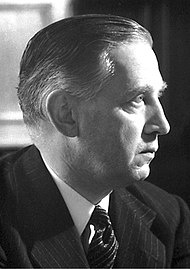Edward Victor Appleton
| Sir Edward Appleton | |
|---|---|
 |
|
| Born | Edward Victor Appleton 6 September 1892 Bradford, West Riding of Yorkshire, England, UK |
| Died | 21 April 1965 (aged 72) Edinburgh, Scotland, UK |
| Nationality | English |
| Fields | Physics |
| Institutions |
King's College London University of Cambridge University of Edinburgh Cavendish Laboratory |
| Alma mater |
Bradford College St John's College, Cambridge |
| Academic advisors |
J. J. Thomson Ernest Rutherford |
| Notable students |
J. A. Ratcliffe Charles Oatley |
| Known for |
Ionospheric Physics Appleton layer Demonstrating existence of Kennelly–Heaviside layer |
| Notable awards | Nobel Prize in Physics (1947) Fellow of the Royal Society (1927) Hughes Medal (1933) Faraday Medal (1946) Chree Medal (1947) Royal Medal (1950) Albert Medal (1950) IEEE Medal of Honor (1962) |
Sir Edward Victor Appleton GBE KCB FRS (6 September 1892 – 21 April 1965) was an English physicist. Nobel Prize winner and pioneer in radio physics. He studied, and was also employed as a Lab Technician, at Bradford Technical College from 1909 to 1911.
He won the Nobel Prize in Physics in 1947 for his seminal work proving the existence of the ionosphere during experiments carried out in 1924.
Appleton was born in Bradford, West Riding of Yorkshire, the son of Peter Appleton, a warehouseman, and Mary Wilcock and educated at Hanson Grammar School.
In 1911, aged 18, he was awarded a scholarship to attend St John’s College, Cambridge, where he graduated with First Class Honours in Natural Science with Physics in 1913.
During the First World War he joined the West Riding Regiment, and later transferred to the Royal Engineers. After returning from active service in the First World War, Appleton became assistant demonstrator in experimental physics at the Cavendish Laboratory in 1920. He was professor of physics at King's College London (1924–36) and professor of natural philosophy at the University of Cambridge (1936–39). From 1939 to 1949 he was secretary of the Department of Scientific and Industrial Research. Knighted in 1941, he received the 1947 Nobel Prize in Physics for his contributions to the knowledge of the ionosphere, which led to the development of radar.
...
Wikipedia
